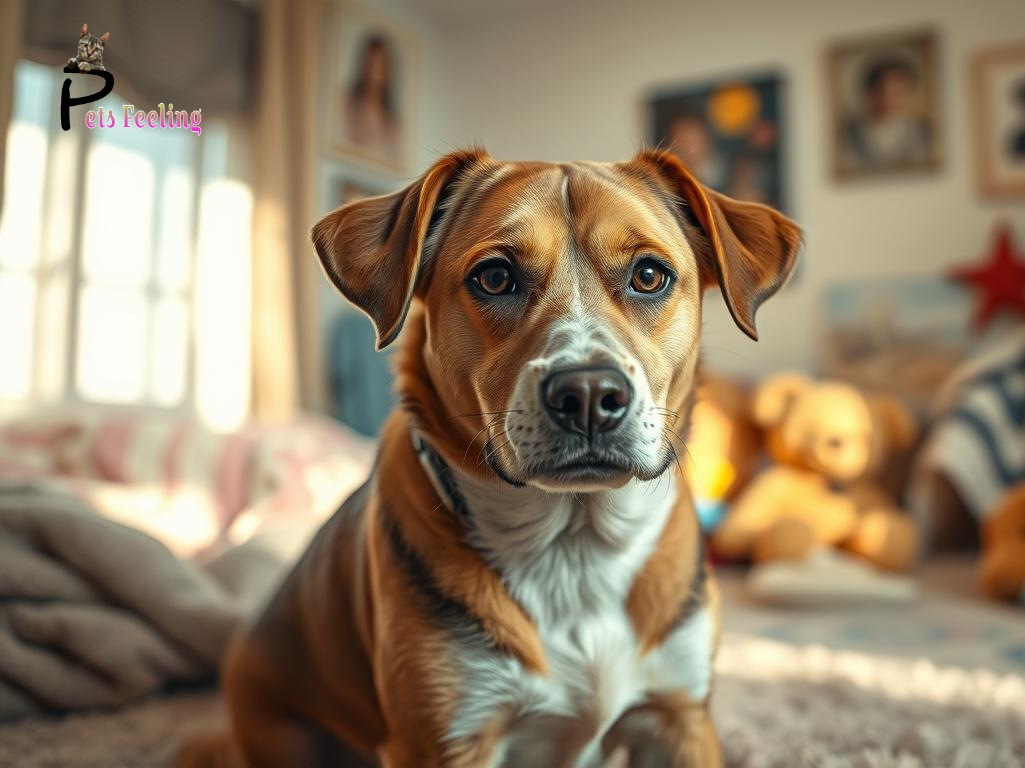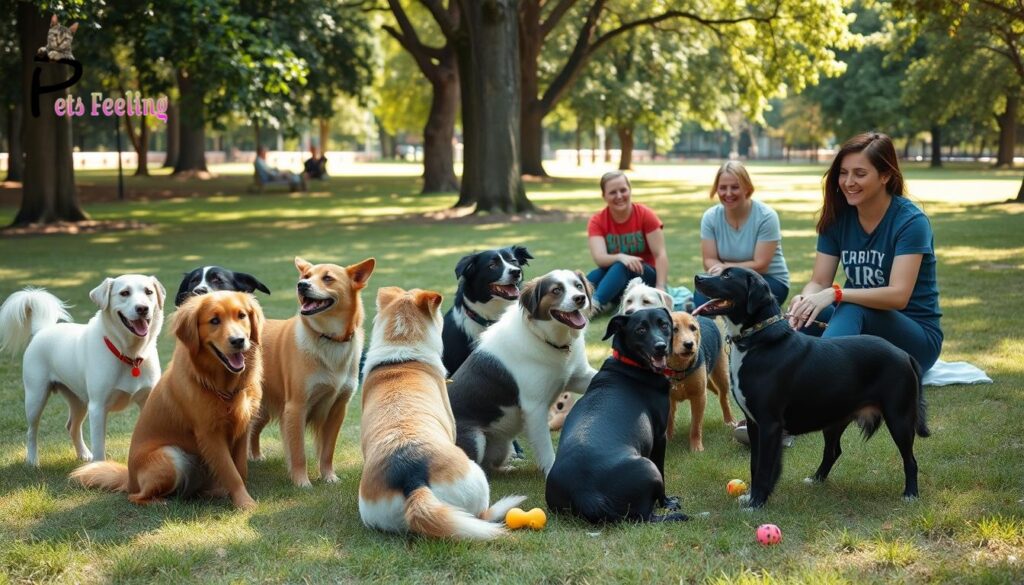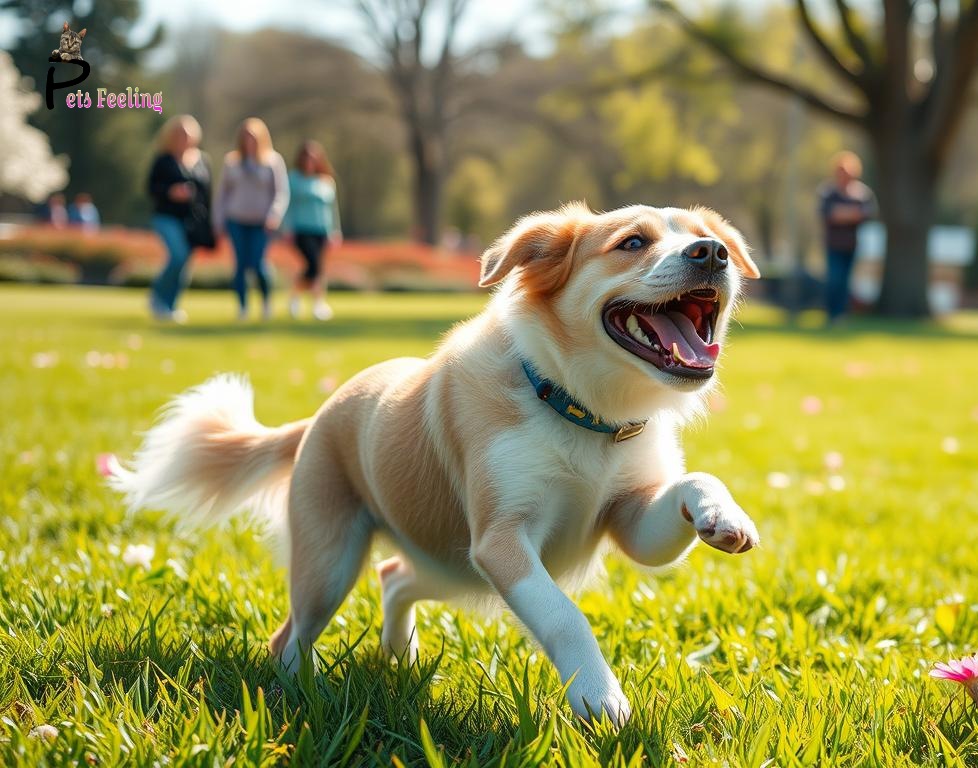Ever thought about helping a dog with a tough past? Helping them can be both rewarding and tough. But, with the right steps, you can help them face their fears and build trust. We’ll look at amazing ways to change their lives, sharing facts that will motivate you to help in 2024.

Key Takeaways
- Understand the impact of trauma on a dog’s behavior and well-being
- Learn effective methods for building trust and promoting positive associations
- Discover the power of positive reinforcement training in rehabilitating fearful dogs
- Create a safe and nurturing environment to help dogs thrive
- Utilize desensitization and counterconditioning techniques to address specific fears
Understanding Canine Trauma and Its Impact
Dogs, like humans, can face traumatic events that leave deep scars. It’s important to know the signs of canine trauma to help them heal. This includes recognizing abuse and neglect and dealing with long-term effects on their behavior and mind. (How to deal with dogs with negative past experiences)
Recognizing Signs of Trauma in Dogs
Spotting trauma in dogs can be tough, but being alert is crucial. Look for signs like cowering, too much barking or aggression, and avoiding people or places. Also, watch for a lack of trust or confidence. Paying attention to your dog’s behavior can help you spot issues and offer support.
The Long-Term Effects of Abuse and Neglect
Abuse or neglect can have lasting effects on dogs. They might struggle with anxiety, fear, and social issues. These problems can show up in many ways, like being overly reactive or not wanting to do normal things. But, with patience and the right help, many dogs can get better and enjoy life again. (How to deal with dogs with negative past experiences)
“The scars of abuse may not be visible, but they can leave a lasting impact on a dog’s psyche. With the right care and support, however, these resilient animals can learn to trust again and thrive.”
Building Trust: The Foundation of Rehabilitation
Building trust is key to rehabilitating dogs with a tough past. These dogs have often faced trauma, neglect, or abuse. They become wary of humans. To help them, you need to earn their trust with patience, compassion, and gentle guidance. (How to deal with dogs with negative past experiences)
To build trust, start by letting the dog control the pace. Never push for interaction or affection. Sit quietly, letting them get used to your scent and presence without fear. Give treats and rewards when they’re ready, to show your positive side. (How to deal with dogs with negative past experiences)
- Respect the dog’s personal space and boundaries.
- Use calming body language, avoiding direct eye contact and sudden movements.
- Engage in low-key activities, such as reading or doing quiet tasks nearby.
- Gradually introduce more interactive play and training, always at the dog’s pace.
As trust grows, you can introduce gentle handling and grooming. This steady, patient approach creates a safe space. Here, the dog can learn to face fears and form a strong bond with you. (How to deal with dogs with negative past experiences)
“The foundation of all animal rehabilitation is trust. Without it, progress is impossible.” – Dr. Emily Weiss, ASPCA Certified Dog Behavior Consultant (How to deal with dogs with negative past experiences)
By focusing on trust, you open the door to change. These dogs can move past their past traumas and become loving, confident friends. With time, consistency, and compassion, you can help them find a brighter future. (How to deal with dogs with negative past experiences)
Positive Reinforcement Training: A Gentle Approach
Positive reinforcement training is a kind and effective way to help dogs overcome past traumas. It rewards good behavior, building trust and confidence in your dog.
Introducing Positive Reinforcement Methods
This training method uses treats, praise, or affection to reward your dog for good behavior. It can be as simple as saying “sit” or as complex as greeting visitors calmly.
Consistency is key. By always rewarding good behavior, your dog learns that it’s worth it. This builds a strong, trusting relationship between you and your dog.
Reward-Based Training for Traumatized Dogs
Dogs with a history of abuse or neglect benefit greatly from positive reinforcement training. They often struggle with fear and mistrust. This method helps them see the world in a positive light. (How to deal with dogs with negative past experiences)
It’s a gentle way to introduce your dog to new things. Using rewards, you can help them feel safe and comfortable. With time and patience, you’ll see a big change in your dog’s behavior and happiness. (How to deal with dogs with negative past experiences)
“Positive reinforcement training has been a game-changer for my rescue dog. It’s allowed us to build a strong bond based on trust and mutual understanding.” (How to deal with dogs with negative past experiences)
Creating a Safe and Nurturing Environment
Working with dogs who have trauma means making a safe space for them. This space needs routines, boundaries, and a quiet area. It’s where they can relax and feel safe. (How to deal with dogs with negative past experiences)
Establishing Routines and Boundaries
Dogs love knowing what’s next. Setting clear routines and boundaries helps them feel secure. This includes regular meals, sleep spots, and a schedule for fun and learning. (How to deal with dogs with negative past experiences)
Providing a Quiet and Secure Space
Rescue dogs also need a quiet spot to call their own. Think of a cozy crate or a room with soft lights and comfy bedding. Slowly introducing new things helps them gain confidence. (How to deal with dogs with negative past experiences)
Creating a safe space is key for dogs with a tough past. It helps them heal and trust again. This trust is the first step to a happier life for them.
Desensitization and Counterconditioning Techniques
Desensitization and counterconditioning are great for dogs with past fears. They help dogs feel better by slowly getting used to scary things. This makes them feel more confident and happy around these things. (How to deal with dogs with negative past experiences)
Desensitization for dogs means slowly introducing them to what scares them. You start with a small version of the scary thing and then make it bigger. You give them treats and praise to show it’s okay. (How to deal with dogs with negative past experiences)
Counter-conditioning for dogs teaches them to like what scares them. You pair the scary thing with something fun, like treats or play. This way, they start to see the scary thing as good. (How to deal with dogs with negative past experiences)
- Identify the specific triggers that cause your dog’s anxiety or reactivity.
- Develop a gradual exposure plan, starting with the mildest version of the trigger.
- Pair the trigger with positive reinforcement, such as treats, praise, or playtime.
- Slowly increase the intensity of the trigger while maintaining the positive association.
- Be patient and consistent, as the process can take time and repeated exposure.
Using canine anxiety management like desensitization and counterconditioning helps dogs. It helps them feel better and more confident. With the right help, many dogs can live happy lives after tough times. (How to deal with dogs with negative past experiences)
How to Deal with Dogs with Negative Past Experiences
Caring for dogs with negative past experiences needs patience and gentleness. Whether it’s an adopted pup or a rescued dog, understanding trauma’s impact is crucial. Using the right socialization techniques can greatly help in their recovery. (How to deal with dogs with negative past experiences)
Patient Handling and Socialization
When dealing with dogs that have faced abuse or neglect, patience is essential. Move calmly and avoid sudden actions that might scare them. Let them get used to new places, people, and things at their own pace. (How to deal with dogs with negative past experiences)
- Prioritize positive dog socialization techniques to build trust and confidence.
- Use patient dog handling methods that instill a sense of security.
- Provide ample time for the dog to acclimate to their surroundings.
Overcoming Fear and Aggression
Dogs with negative pasts may show fear or aggression as a defense. To tackle these issues, you need a mix of desensitization, counterconditioning, and positive reinforcement training. (How to deal with dogs with negative past experiences)
- Gradually desensitize the dog to triggers that elicit fear or aggression.
- Use counterconditioning techniques to link positive experiences with negative stimuli.
- Implement reward-based training to encourage good behavior and boost confidence.
By showing patience, consistency, and a dedication to overcoming aggression in neglected canines, you can help them heal. They can then thrive in their new, loving home. (How to deal with dogs with negative past experiences)

The Importance of Professional Support
When dealing with dogs that have had negative past experiences, getting professional help is key. Certified trainers and animal behaviorists bring the needed knowledge and skills. They help tackle the unique challenges these dogs face. (How to deal with dogs with negative past experiences)
Working with Certified Trainers and Behaviorists
Certified trainers and behaviorists know a lot about dog behavior. They can spot canine body language and trauma cues easily. They create a plan just for the dog, helping it feel safe and overcome fears or aggression. (How to deal with dogs with negative past experiences)
Also, working with certified trainers and behaviorists helps pet owners a lot. They teach owners how to interact with their dogs the right way. This helps reinforce good behaviors. (How to deal with dogs with negative past experiences)
| Benefits of Working with Certified Professionals | Potential Risks of DIY Rehabilitation |
|---|---|
| Customized rehabilitation plans Expertise in canine body language and trauma cues Hands-on training for pet owners Increased chances of successful rehabilitation | Lack of specialized knowledge Potential for unintended negative consequences Prolonged recovery or further trauma Safety risks for both the pet and owner |
By working with certified trainers and behaviorists, pet owners can feel more confident. This ensures the best results for their dogs.
Rehabilitation Success Stories: Inspiring Transformations
Many dogs have overcome tough pasts thanks to rehabilitating neglected dogs and building trust with rescued pets. The use of positive reinforcement training for traumatized pets has helped them. Now, they are confident and loving friends. (How to deal with dogs with negative past experiences)
Bella, a shy Labrador, was rescued from abuse. Her caretakers used patience and a routine to win her trust. With positive reinforcement training, Bella learned to face the world without fear. She became a happy and loving family dog. (How to deal with dogs with negative past experiences)
“Witnessing Bella’s transformation was truly inspiring. She went from cowering in the corner to enthusiastically playing and seeking out cuddles. It’s a testament to the power of compassion and building trust with rescued dogs.”
Buddy, a Pit Bull mix, had a long history of neglect. Caregivers used rehabilitating neglected dogs and positive reinforcement training for traumatized pets to help him. Now, Buddy is a confident and loyal friend, bringing joy to his family.

These stories show that even the most troubled dogs can find happiness. With the right care and positive reinforcement training, they can thrive. Professionals and pet owners can make a big difference in their lives.
Preventing Future Trauma: Responsible Pet Ownership
Understanding how to help dogs with bad pasts is key. Responsible pet ownership plays a big role in stopping future trauma. We must treat animals with kindness and care to ensure they get the support they need. (How to deal with dogs with negative past experiences)
Advocating for Humane Treatment of Animals
Preventing future trauma starts with treating animals with respect. We need to speak out against animal cruelty and support laws that protect dogs. Overcoming dog aggression from abuse, socializing previously unsocialized dogs, and practicing patience with dogs overcoming trauma are all important steps. (How to deal with dogs with negative past experiences)
- Educate yourself and others about the signs of animal abuse and neglect.
- Volunteer or support organizations that rescue and rehabilitate abused or abandoned dogs.
- Advocate for tougher laws and enforcement against animal cruelty in your community.
- Encourage responsible pet ownership through public awareness campaigns and community outreach.
By actively promoting humane treatment, we can prevent future trauma. This way, all dogs can live happy, fulfilling lives.
| Action | Impact |
|---|---|
| Educate yourself and others about animal abuse | Increased awareness and ability to identify and report abuse |
| Volunteer or support rescue organizations | Provide resources and support for rehabilitating abused or abandoned dogs |
| Advocate for stronger animal cruelty laws | Deter and punish those who engage in animal abuse, creating a safer environment for dogs |
| Promote responsible pet ownership | Prevent future cases of abuse and neglect through education and community engagement |
By following the principles of responsible pet ownership and advocating for animal welfare, we can build a future where dogs are loved and cared for. This future will be free from the trauma of the past, allowing dogs to live in loving homes.
The Road to Recovery: Patience and Consistency
Helping rescued dogs or pets with fears is a long journey. It needs patience and consistency. The path to healing is not always straight. It’s filled with ups and downs.
Every dog’s story is different. Some may open up quickly, while others need more time. It’s important to understand and adjust your approach for each dog.
- Maintain a calm and reassuring demeanor, even in the face of challenges.
- Establish a consistent routine that provides a sense of security and predictability.
- Celebrate small victories, as they are the building blocks of lasting change.
Recovery is a long-term effort, not a quick fix. With patience, love, and understanding, you can help dogs find happiness. They can learn to feel safe and loved.
“The true measure of a person is how they treat someone who can do them absolutely no good.” – Ann Landers
Every small step forward shows the strength of dogs and the power of care. Open your heart to this journey. You’ll see amazing changes when a broken soul starts to trust again.
Conclusion: The Rewards of Rehabilitating Traumatized Dogs
Rehabilitating dogs with a tough past is a tough but rewarding task. Using positive training, a safe space, and calming methods can change them. You’ll see these dogs grow strong and confident.
The bond with a dog who’s been abused is unique. Seeing them face fears, trust again, and become happy friends is amazing. Your patience and care help them feel safe and joyful, enriching your life too.
Keep moving forward on this journey, celebrating every small win. By helping abused dogs heal, you’re changing lives and making the world better for animals. Trust the process and know you’re making a big difference in their lives.
FAQ
What are the signs of trauma in dogs?
Dogs with trauma might seem very scared or anxious. They might also get aggressive or avoid people. Other signs include barking a lot, not trusting new people, and feeling uneasy in new places. Spotting these signs is the first step to helping them.
How can I build trust with a dog that has experienced trauma?
Building trust with a traumatized dog takes time and patience. Start by slowly introducing yourself and moving calmly. Avoid staring or sudden movements. Use treats and praise to make them feel good around you. A regular routine helps them feel safe.
What is the role of positive reinforcement training in rehabilitating traumatized dogs?
Positive reinforcement training is very helpful for dogs with a bad past. It’s a gentle way to teach them new things. It builds their confidence and helps them see humans in a positive light.
How can I create a safe and nurturing environment for a traumatized dog?
Creating a safe space is key for a traumatized dog. Set up routines and boundaries. Give them a quiet, safe area. Introduce new things slowly to keep them comfortable.
What are desensitization and counterconditioning techniques, and how can they help traumatized dogs?
Desensitization and counterconditioning are great for dogs with fears. Desensitization slowly gets them used to scary things in a good way. Counterconditioning makes them associate these things with good feelings and rewards.
Why is it important to work with professional trainers and behaviorists when dealing with traumatized dogs?
Working with experts is very helpful for dogs with a bad past. They know how to help dogs feel better. They create special plans and support the dog every step of the way.
What are some inspiring success stories of rehabilitating traumatized dogs?
Many dogs have overcome their pasts and now live happy lives. Their stories show how strong and resilient dogs can be. With the right care, they can change a lot.
How can we prevent future trauma and promote the humane treatment of animals?
We can prevent trauma by treating animals well and teaching others to do the same. This means supporting animal groups and making sure dogs get the care they need. This helps them stay happy and healthy.
What is the key to successfully rehabilitating a traumatized dog?
The main thing is to be patient and consistent. It takes time, but with kindness and support, dogs can heal. They can learn to trust again and become happy, well-adjusted pets.
IMPORTANT ADDITIONS
Edited on , 27 OCT ,2024
Read more articles : https://petsfeeling.com/blog-2/
social media :
facebook : https://www.facebook.com/PetsFeeling0/
tiktok : https://www.tiktok.com/@pets.feeling
instagram : https://www.instagram.com/pets._.feeling/
youtube : https://www.youtube.com/@Pets-Feeling

